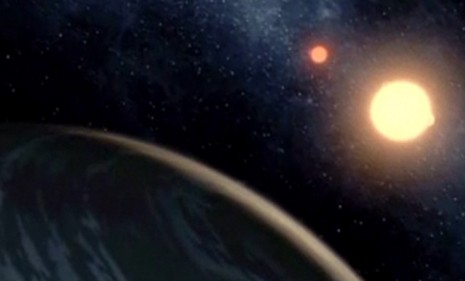Found: A real-life Star Wars planet
Astronomers are thrilled by the discovery of a planet that orbits two suns — just like bleak Tatooine that Luke Skywalker calls home

Astronomers have discovered a new planet and christened it with a typically uninspiring name. But to millions of Star Wars fans, "Kepler-16b" might as well be called Tatooine, since it shares an unusual feature with Luke Skywalker's home: Each planet orbits two suns. Besides the discovery's "wow factor," it's rewriting the book on such phenomena. Here's what you need to know:
Sorry, I'm not especially Star Wars savvy — what's the connection?
In a stirring scene early in the first Star Wars film (1977), the restless young hero, Luke Skywalker, walks outside his home on the desert planet Tatooine and watches two suns set at once. (View the clip here.) "The essential strangeness of that image made it quietly but profoundly clear that you were visiting an utterly foreign world," says Michael D. Lemonick at TIME.
The Week
Escape your echo chamber. Get the facts behind the news, plus analysis from multiple perspectives.

Sign up for The Week's Free Newsletters
From our morning news briefing to a weekly Good News Newsletter, get the best of The Week delivered directly to your inbox.
From our morning news briefing to a weekly Good News Newsletter, get the best of The Week delivered directly to your inbox.
And now astronomers have found Tatooine's equivalent?
Well, not quite. Although Kepler-16b does have two suns just like Luke's home, the real-life planet is extremely cold. Even though it has two suns, they’re smaller than our sun, so a warm day on Kepler-16b would be minus 100 degrees Fahrenheit. "You better have your long underwear," says astronomer Alan Boss, as quoted at MSNBC. At those temperatures, it’s unlikely the rocky planet could harbor life.
Are there other two-sun planets?
Although astronomers had to look 200 light years away to find Kepler-16b, they believe that there are billions of double-star systems in the Milky Way. It's likely that future interplanetary research will reveal more Tatooines.
A free daily email with the biggest news stories of the day – and the best features from TheWeek.com
Does this discovery add much to astronomers’ knowledge?
Definitely. Aside from confirming that stable two-sun planets like Kepler-16b actually exist, it disproves something astronomers had long believed: That a two-sun planet would have to be at least seven times as far from its suns as the two suns were from each other. "This planet broke the rule," says astronomer Sara Seager, a planetary expert at the Massachusetts Institute of Technology, as quoted in The New York Times.
Sources: Discovery News, MSNBC.com, NY Times, TIME
-
 Metaverse: Zuckerberg quits his virtual obsession
Metaverse: Zuckerberg quits his virtual obsessionFeature The tech mogul’s vision for virtual worlds inhabited by millions of users was clearly a flop
-
 Frank Gehry: the architect who made buildings flow like water
Frank Gehry: the architect who made buildings flow like waterFeature The revered building master died at the age of 96
-
 Is MAGA melting down?
Is MAGA melting down?Today's Big Question Candace Owens, Tucker Carlson, Laura Loomer and more are feuding